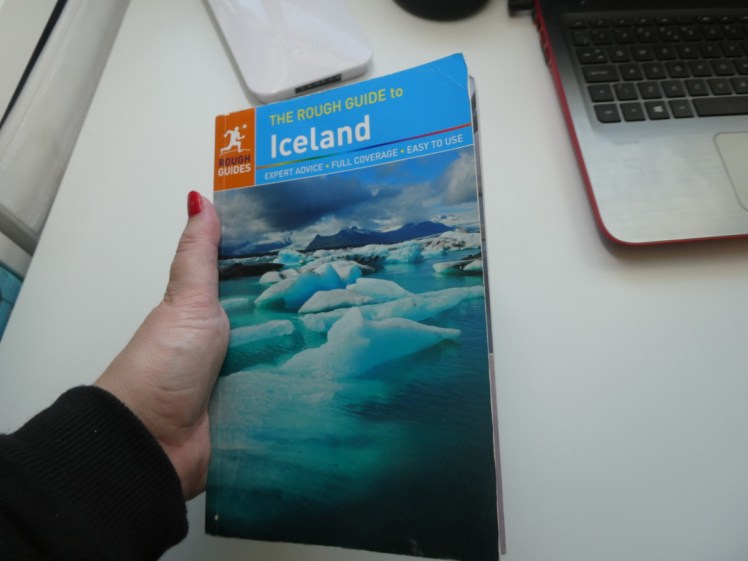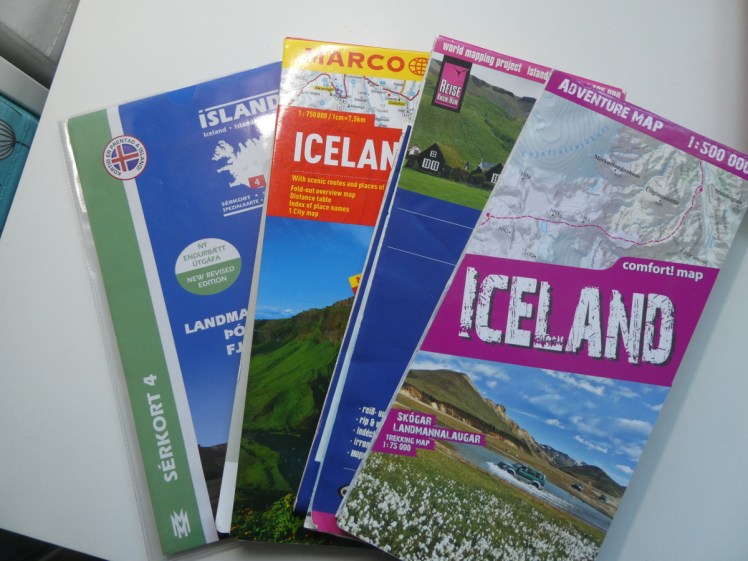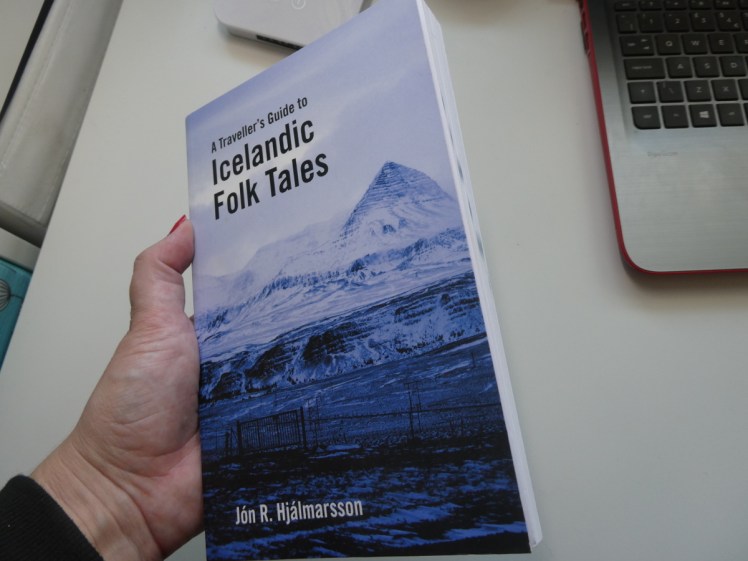I’ve been writing some Iceland blogs lately and I’m also trying to write an uncooperative and recalcitrant Iceland Book. That means I’ve had my little Icelandic reference library out. It’s not quite what you would find in a real library but I find it handy and I thought it might be useful to you to see what I use when I want to check things out.
(By the way, where there’s a link to buy the book, it’s an affiliate link from bookshop.org, a kind of online collective of independent bookshops and therefore a great way, especially during a pandemic, to support bookshops other than That Really Big One)
Number 1 is my guidebook. Actually, I have two guidebooks. They’re both Rough Guides because I really like the Rough Guides and haven’t yet got on very well with any other brand. I have the March 2007 3rd edition which is crinkly from being left in a bag near something wet and the one I use is the April 2013 5th edition. I love guidebooks. I know they go out of date almost before they’re printed in terms of accommodation and cafes and even buses but they have close-up maps and dates and stories and information and so much that’s useful to know that doesn’t go out of date.

Next is my map collection. I have four maps, plus the Illustrated Map from the tourist information centre up on the wall behind me. My first one was the Mál og Menning number 4 Landmannalaugar/Þórsmörk/Fjallabak map (non-affiliate link to Stanfords) which is the one recommended for the Laugavegur Trail. It’s a nice map but I’m from the UK. I’m used to navigating trails with the 1:25 000 OS Explorer maps and this 1: 100 000 is unsatisfying. But on the back it’s got little paragraphs about all the places of interest in the area. It’s not a bad map, it’s just not OS.

My next one is the Marco Polo Iceland map. It’s a road map rather than a hiking map so I’m perfectly happy for it to be at 1: 750 000 scale. It’s no good for navigating within Reykjavik – or within any other settlement – but it does the job just fine for driving around the Ring Road and it fits the entire country on one page, so that’s nice. It has close-ups of the Myvatn and Þingvellir areas and more mysteriously, Hekla. It’s not detailed enough for hiking but there’s one F road cutting across the corner and I can’t entirely see what the purpose of including it is. It also has a close-up of central Reykjavik so I take back the “can’t navigate in Reykjavik” comment. I don’t really use this map much because I don’t really like the texture of the paper. Yeah, I’m ludicrous like that. It’s a good driving map and I’d use it if I didn’t have one I personally prefer.
The map I use for driving is the Reise Know-How 1:425 000 (non-affiliate Stanfords link). It’s slightly shinier paper – well, no. It feels shinier but it doesn’t look shinier. The cover says it’s rip- and water-proof and that figures. It’s bigger than the Marco Polo and you have to turn it over for the other half of the country and it doesn’t have any close-up inserts but it’s so big and so detailed and so easy to handle and I just really like this map. If I need a map for navigating, this is the one I’ll go for.
My last map is my preferred Laugavegur map, the Terraquest Adventure Map. This is a laminated map with every panel separated by a few millimetres of plastic. What that means is that you can fold it in whatever direction you like without upsetting it and without stressing the paper until it comes apart. It has a 1:500 000 Iceland map which is a perfectly good driving map, particularly as I can fold it so only the pages I want are visible. But it has a 1:75 000 Laugavegur map which is so much more usable for my liking than the Mál og Menning map. If I feel the need to consult a map while I’m writing a blog post, it’ll probably be this one but if I want a bit more detail, I might grab the Reise.
While I’m still talking about the Laugavegur trail, I’ll often check with my Cicerone Walking and Trekking in Iceland book (non-affiliate Stanfords link). It features 49 day walks and 10 multi-day treks and of course, it has the Laugavegur trail. I’ll pick it up to check on technical details mostly, names of mountains and rivers, times, heights etc. It’s a handy book and I should do a little more walking and use a few of the other pages.

My next book is one that’s sitting in the cube next to my desk because I was using it for my Ultimate Iceland Guide map the other day and that’s Thermal Pools in Iceland by Jón G. Snæland & Þóra Sigurbjörnsdóttir. It’s what it sounds like – a guidebook to thermal pools. Some of them are big places like the Blue Lagoon and Myvatn Nature Baths and some of them are muddy puddles or troughs on farmland and one of its cover stars is the Viti crater. I’ve never really made enough use of this book for finding and visiting hot pools.

Another one I’ll pick up for writing references rather than visiting reference is A Traveller’s Guide to Icelandic Folk Tales by Jón R. Hjálmarsson, which groups together ghoulies and ghosties and weird Nordic beasties by location. Some of them are tales you might pick up from a tour guide on a long bus journey and some of them are tales that don’t appear in English anywhere else and I’m finding it very handy for introductory stories in my second book (which sounds like I’m helping myself to bits of his work; I’m not, I’m just looking for the finer details of stories I only half remember).

Then there’s the sagas. The crown of this collection is The Sagas of Icelanders, which is a huge and beautiful book put together by Jane Smiley. It contains 11 sagas (if you count the two sagas that make up The Viland Sagas as two) and 6 tales. The one I’m surprised it doesn’t contain is Njal’s Saga, which is kind of the Hamlet of Iceland. But it does contain Egil’s Saga and the Saga of the People of Laxardal and those three are the big ones. I really want to read Egil’s Saga and it just doesn’t work for me which is why I also own that in a stand-alone book (which I haven’t read) and a mini-edition, like an abridged version for children or tourists (which I also haven’t read). I wish I could because it’s a great saga. The Sagas of the Icelanders is a gorgeous book but it’s quite big and heavy and that’s why I thought having Egil separately might make it easier to read.

Other sagas I own are Sagas of Warrior-Poets which is another collection, but a smaller one this time, The Saga of Grettir the Strong, Orkneyingas Saga, which is about the kings of Orkney, Volsungs Saga and the standalones of Egil’s and Njal’s.


Then I have the Poetic and Prose Eddas which are by their nature reference books. Our old friend Snorri Sturluson wrote the Prose (or Younger) Edda, which is easier to read and contains the Gylfaginning which tells the story of how the world came into being, Skáldskaparmál, which is about poetry and language and kennings, and Háttatal which is pretty much a dry academic text on poetric forms. The Poetic Edda is a series of epic poems of various lengths. You may have heard of Lokasenna, which is the one where Loki crashes a party, gets drunk and insults everyone. These two books basically contain everything known today about the Old Norse religions. If Icelanders hadn’t sat writing down stories on cold dark nights, it might all have been lost and then no one would ever have heard of Tom Hiddleston. It’s all translated into English of course, I don’t read Old Norse, but it keeps some of the awkwardness and style and phrasing and it’s awkward to read in the same way that Shakespeare is. I tend to read sagas with a pencil in one hand and a finger in the notes that inevitably make up the last quarter of the book, annotating it so that I have a clue what’s going on.

Let’s just finish off that bit of shelf. Next to the Eddas is the Kalevala, which is the Finnish national epic and it makes the Eddas look small and unambitious. At the other end is Neil Gaiman’s Norse Mythology (honestly, just read the Eddas), Joanne M Harris’s Gospel of Loki and Tolkien’s Legend of Sigurd and Gudrún, which is his telling of a chunk of Volsungs Saga in poetic form.
Any others? I do have a language book called Colloquial Icelandic but I don’t use it and had forgotten it existed until I rearranged my shelves when All This started. I have a small collection of Icelandic fiction but I don’t use that as reference.
So that’s my set of reference books.